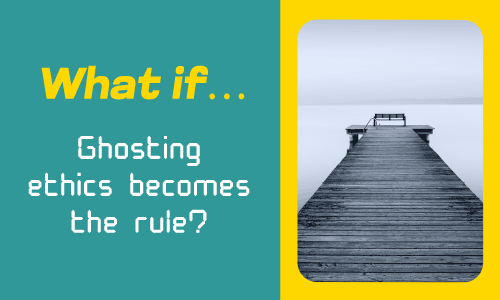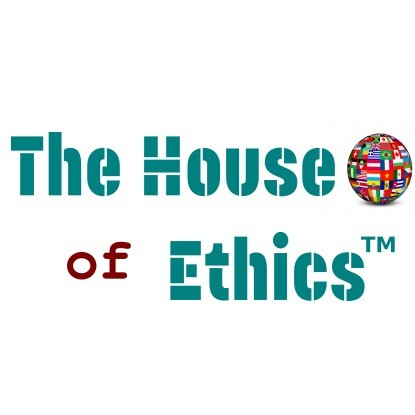The NFT Tsunami : about (N)othingness (F)renzy and (T)iepolo
The NFT Tsunami : about (N)othingness (F)renzy and (T)iepolo
The recent explosion of NFTs was a catalyst to many questions around non-fongible tokens and the art world. NFTs are at the crossroad of art, technology, energy, money, and our sense of aestetics. The analogy with a tsunami illustrates both power and losing control. And that’s what NFTs are about right now. “Anything goes” like Cole Porter used to sing.
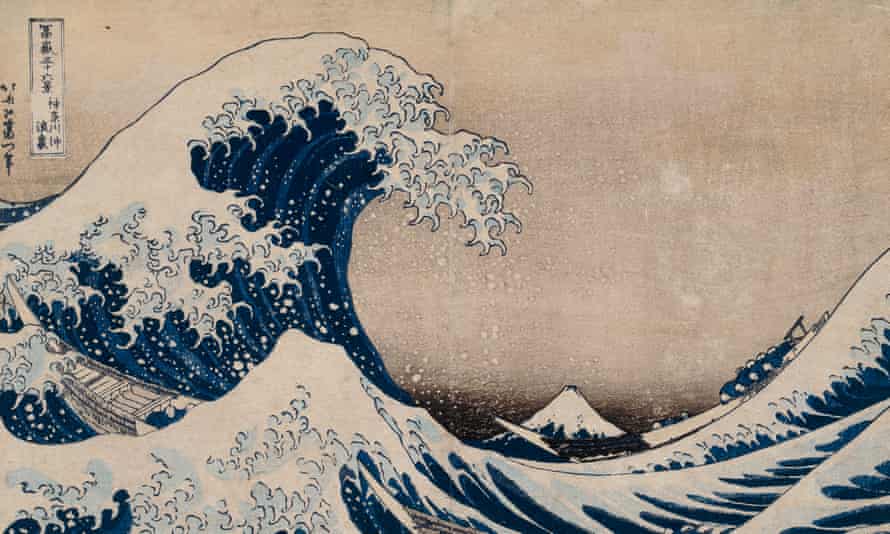
Tsunami and mass production
On Thursday, March 11th, Christie’s sold a collage of digital art images for $ 69 million. The artist Beeple became the third-highest selling living artist behind Jeff Koons and David Hockney. The Beeple phenomenon shook the art world. But not only.
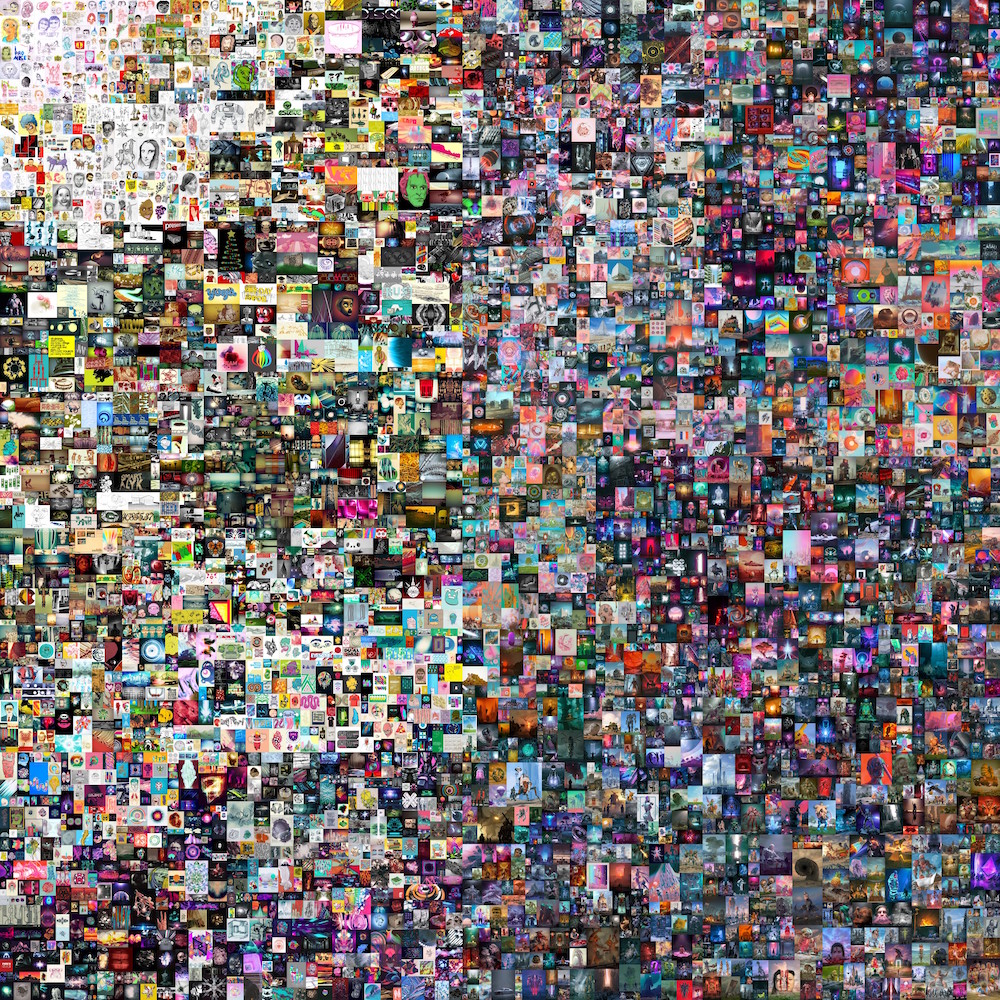
Ever since, we are witnessing an explosion of NFT production and hallucinating amounts invested in digital art by crypto-rich investors. The NFT marketplace OpenSea secured $100 million in second funding round and is valued at $1.5 billion.
As Co-founder and CEO Devin Finzer puts it “the market has “shifted” to niche projects experimenting in ways “weird and strange.””
“The art is still really cool, but gaming, event ticketing, domain names, those sorts of use cases” have moved into position. Source
Model T, NFT and Frenzy
Nearly 110 years ago, Ford’s assembly line started rolling. We are in 1913. A new concept that shaped the capitalist economy : mass production.
Production time for a car was reduced from 12 hours to 1 hour 33 minutes. New words came to meaning : productivity, efficiency, streamlining. And, assembly line.
That’s what the NFT world is offering us right now. Mass Production of digital art. However, mass production is nothing new in art. Warhol was already mass producing in his Factory. A real power station on Manhattan’s East Side.
This new NFT movement has been creating a real hype with people outside the art scene.
Christie’s website saw 22 million visitors tune in during the final minutes of the sale. The majority (58 percent) of bidders were millennials, according to the auction house, while Gen X comprised 33 percent. There were relatively few Gen Z bidders (6 percent) and Boomers (3 percent). Nearly all of them—91 percent—were new buyers to Christie’s. Source
What incidence does this mass movement have on art? Will art become a leisure activity or commodity? A non-effort, no-talent uploadable technique?
The NFT we created for the House of Ethics – for fun – is a perfect exemple of how easyly you can tag a simple .png as art. Find a platform and offer it to interested bidders. We published it on opensea.io. It was as easy as that. But is it art?
Katja Rausch, the founder of the House of Ethics, certainly did not think so. She regarded it rather as a provokative means to express doubts and raise questions. That’s why we choose the title “Ad absurdum ad absurdum ad absurdum ad absurdum ad absurdum Ad” published on opensea.io under collection unit 80576709.
It acts like an ad, a farce, a magical tour filled with humor.
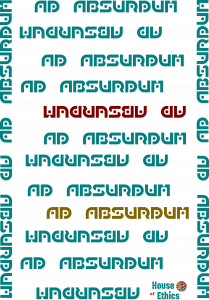
Regardless what we think, the NFT hype, the frenzy, is undeniable. Underlying questions nevertheless need to be asked : what kind of impact will the NFT mouvement have on art? Will this kind of collective techno-art revive a global folk art movement? Will the art world become attractive to new audiences, using new technologies?
Do we need to redefine, from an ontological perspective, what art really means? This could also apply to robotic art.
When AI powered machines disguised as humanoids in silicon declare themselves being artists, what does it mean for art? Refering to the “artist-robot” Ai-Da or Hanson Robotics’ Sophia.
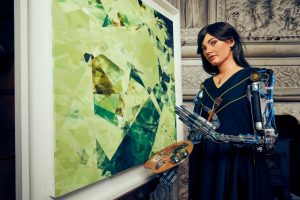
Crypto tokens for digital ownership
NFTs are crypto tokens, just like like any cryto currency, Ethereum, Bitcoins.Each NFT has an address on Blockchain, thus publicly verifiable. If you own an NFT means that you own the cryptographic key proving your ownership. Each NFT is unique and thus they allow to transfer ownership of art objects to individual buyers. You own it. But more exactly, your digital wallet is listed as the owner.
But why is it important? And for whom?
Because in the digital world, with social platform, distribution networks like YT, files (video, pix, audio…) have become replicable, shareable, and ownerless.
With NFTs an artist can transfer ownership to an individual buyer. And get paid.
Many questions arise. What do you own? Why does everybody participate in this hype? And what about data?
How to set up a wallet
NFT rights. What do we own?
NFTs transfer ownership from one person to another; digital ownership. So do we actually own something?
It is very elucidating and sobering to have a look at Christie’s conditions of sale.
The 33-page document (!!!) has a specific section for NFTs. It starts on page 12. With numerous “You acknowledge…” paragraphs.
The most important statement about ownership is to be found on page 14.
Your wallet owns, Not you!
“If you make payment in Ether from a digital wallet, you represent that the source of wealth for the digital wallet is not attributable, either directly or indirectly, to (i) a citizen or resident of, or located in, a geographic area that is the target of sanctions or embargoes imposed by the European Union, the United Kingdom, the United Nations or the United States […]
“You acknowledge and agree that there are risks associated with purchasing and holding NFTs. By purchasing, holding and using NFT…”
“You acknowledge that your purchase of an NFT complies with applicable laws and regulation in your jurisdiction.” Christie’s condition of sale -page 13
“You acknowledge that ownership of an NFT carries no rights, express or implied, other than property rights for the lot (specifically, digital artwork tokenized by the NFT).
You understand and accept that NFTs are issued by third parties, and not by Christie’s itself.You acknowledge and represent that there is substantial uncertainty as to the characterization of NFTs and other digital assets under applicable law.”
What about liability? That’s what Christie’s condition of sale declare:
We cannot and do not represent or warrant that an NFT isreliable, current or error-free, meet your requirements, or that defects in the NFT will be corrected. We cannot and do not represent or warrant that an NFT or the delivery mechanism for NFT are free of viruses or other harmful components.“
So what do we actually own?
Since NFTs are just pointers to an IP address of a piece of digital art, do we have control over the aquired piece? Can we stop its circulation/altering/reproduction on the Internet. Probably not. Not yet, at least.
Any NFT purchaser might assume to own the art associated with the NFT; however, in reality, the original creator is the copyright owner who retains the exclusive right to copy, distribute, modify, publicly perform, and publicly display the art.
Fractional ownership
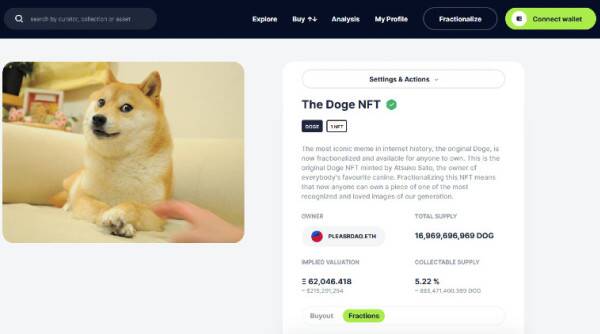
It is the incredible story of the Dogecoin Meme NFT : an unique picture of the well-known Shiba Inu named Kabosu picture being bought for $ 4 million, sliced up or “fractionalized” it into 16,969,696,969 tokens, (YES!!! 17 billion items!!!!), and resold 20% of them for $45 million, shooting the price of the entire dog picture up to a stellar $225 million.
Basically, buying a token doesn’t get you one particular pixel of the dog picture; it gets you one (1/16,969,696,969) share of the whole picture. Not a specific part of the dog, the nose, the tail or the ear.
Call it “fractional ownership” of a non-fungible token (the dog picture).
Data privacy, data security and data deluge
NFT auctions are based on data, need data to store and transaction, need energy to run on the blockchain or other chains, meaning are highly energy-consuming.
NFT data privacy conflicts with the blockchain’s essence on which is it based. Two major points are standing out:
GDPR “assumes” that there is at least one data controller can be addressed by a data subject (an individual). However the blockchain works with multiple players and decentralisation.
GDPR grants certain rights (e.g. the right to data rectification, the right to data erasure) to the data subjects, which again contradict the “blockchain values” of the shared, permanent, unchangeable layers for safely recording transactions.
Data storage
An NFT and the digital art piece it represents are typically stored separately. The NFT is stored on the blockchain and contains information on where the digital asset is located. The NFT is connected to the digital asset via a link. However, if the digital asset is deleted or the server hosting it fails or otherwise goes offline, the link will break and the NFT that remains will be worthless. Source
Besides data privacy issues, data security has become a serious issue. Even though the blockchain has been hailed as the safest technological application.
NFTs : a goldmine for cybercriminals
The tweet of an user victim to a NFT-theft. Access keys are being mostly stolen by phishing. For digital items, you lose the ownership. Nothing more since copies are everywhere. Theoretically your piece of art is not lost, just your access to ownership on nothing.
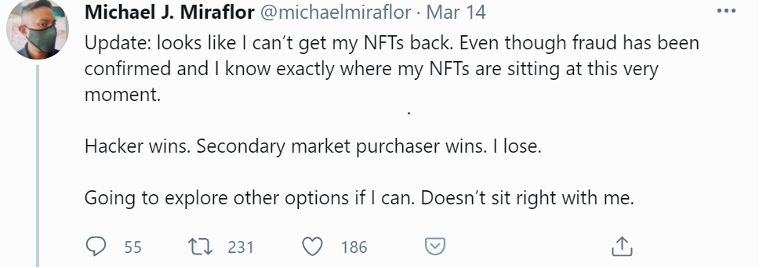
NFT carbon footprint calculated
Currently, digital-currency operator Ethereum, for example, has about the same energy usage as the whole of Zimbabwe.
There is energy consumption and carbon emissions for each NFT generated. For one single NFT transaction – source :The Unreasonable Ecological Cost of #CryptoArt
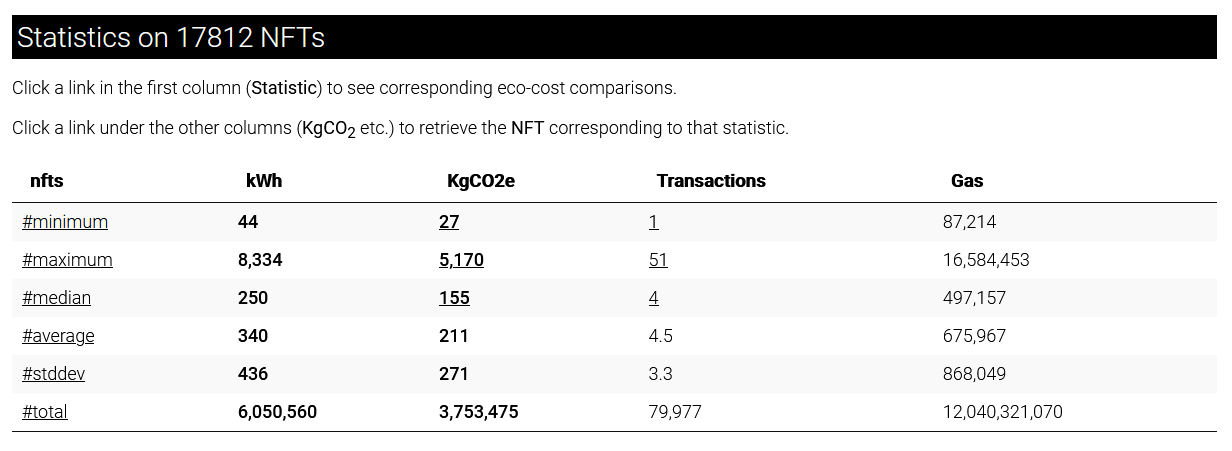
Rococo painter Tiepolo and Hokusai
How can 18th century rococo painter Giambattista Tiepolo’s painting “La verità svelata dal tempo” (“Time unveiling Truth”) be relatable to the current NFT hype? On several levels.
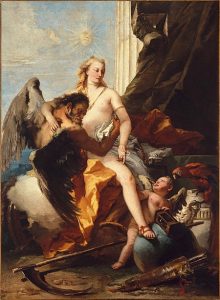 First by its title. Even if we are scepticle about the hype, the essence of art, the use of tremendous amount of energy to make the system work, the shady concept of blurred ownership, the pharaonic amounts of money being spent, the predominance of a new transactional facet of techno-art, we need to wait and see. Time will unveil truth.
First by its title. Even if we are scepticle about the hype, the essence of art, the use of tremendous amount of energy to make the system work, the shady concept of blurred ownership, the pharaonic amounts of money being spent, the predominance of a new transactional facet of techno-art, we need to wait and see. Time will unveil truth.
The bounderless nature of NFTs. They can be attached to everything. On paintings, sculptures, X-rays of William Shatner’s teeth, football players like Messi with his latest Messiverse NFT art collection, and century-old Master Art. Lately The Bristish Museum has proudly announced the introduction of NFTs on lacollection.io by 17th century artist Hokusai, best known for his overwhelming The Great Wave.
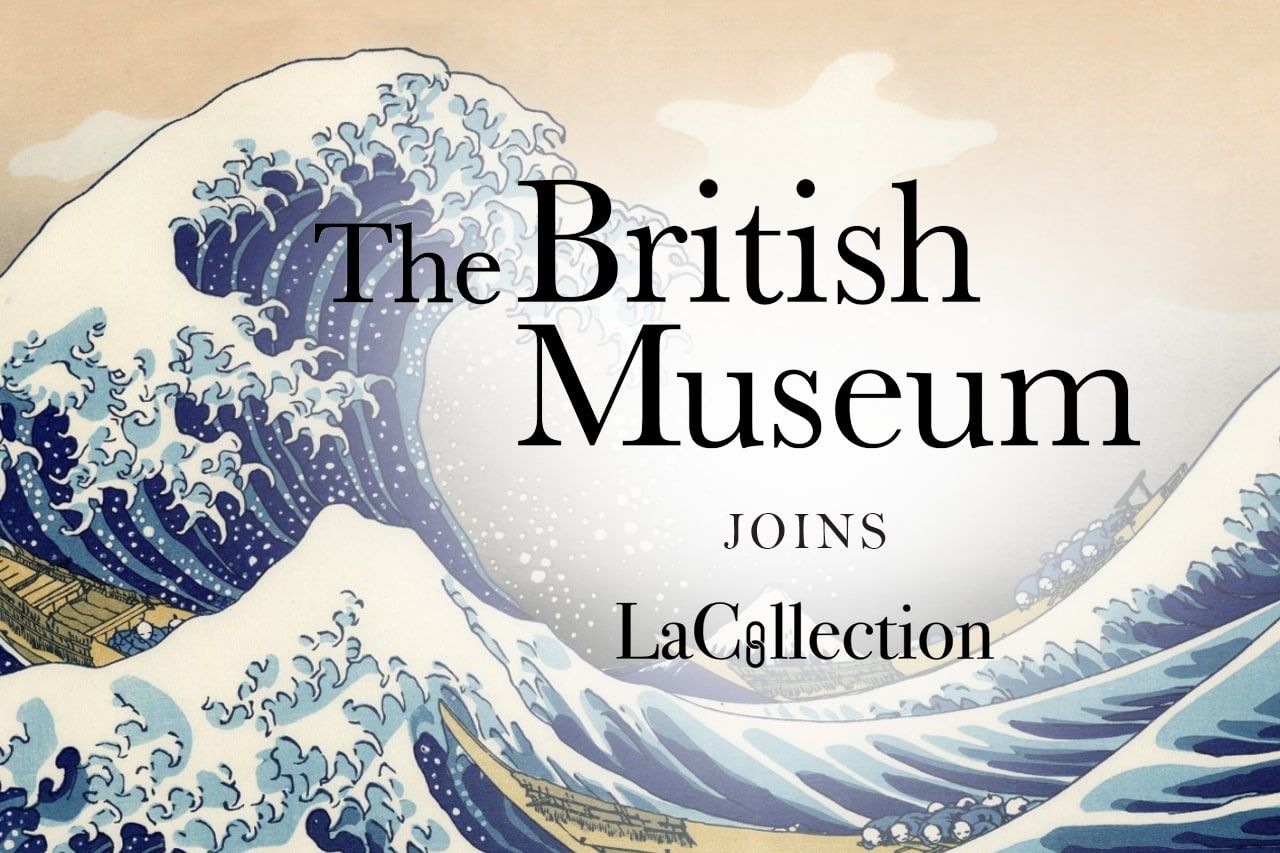
Where does the NFT market go? Will it change the notion of art or will it shift away from art into more consumable and affordable objects? That’s at least what the CEO of opensea.io Devin Finzer thinks when talking about the longevity of NFTs.
Other blockchains better support low-value, high-volume projects like event ticketing or gameplay that OpenSea plans to court. Source
Nevertheless the NFT boom is a complex and emergent form of financial manipulation, a way for people in the crypto ecosystem to pump up the value of that ecosystem by trading just anything at abnormally high values.
The question is :after the tsunami will art be the winner or loser?
Plenty of Nothing
When Italian artist Salvatore Garau sold an invisible sculpture for $18,000, a line had been crossed. The work, titled Io Sono or “I Am,” doesn’t exist except in the artist’s imagination.

“The vacuum is nothing more than a space full of energy,” Garau explained. “And even if we empty it and there is nothing left, according to the Heisenberg uncertainty principle, that ‘nothing’ has a weight. Therefore, it has energy that is condensed and transformed into particles, that is, into us.”
More absurdly, the buyer gets a certificate proving that he owns … nothing.
Nihilism, Void or Nothingness
Recently a new adjective has been attached to the NFT market. “Nihilistic”.
Now here, the intent is very clear. Investment and speculation. It’s about money. Neither about dogs nor art.
The story of the DogeCoin meme that was split into 17 billion parts, nearly into nothing, physically fractions the item to a nanoparticle. Nearly into Nothingness.
FRIDGE and his latest piece Nothing F*cking There
New York-based but Brooklyn-born multidisciplinary (and underground) artist FRIDGE was also getting in on the NFT art frenzy — with his piece is Nothing F*cking There.
The magazine New York Time Out eloquently titled an article about the Fridge mania “This scannable NYC billboard lets you bid on an invisible piece of art”
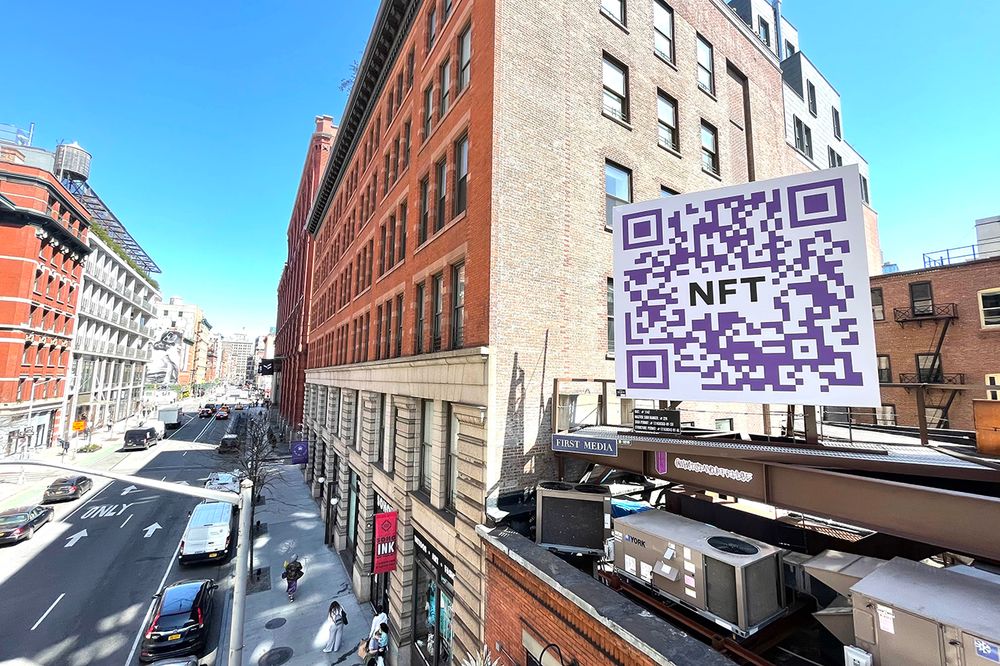
Nothing F*cking There is composed of, quite frankly, nothing. It’s a QR code with 3 letters – NFT.
Anybody can place a bid on this billboard and “own a moment in time” according to 29-year-old FRIDGE.
“The billboard is my way to inspire someone that if you stop doing nothing, you can achieve anything, even if you’re selling nothing.”
But there is another void, nothingness, nihilism, more and more people tend to associate the NFTs with.
Mark Hurst wrote on March 18, 2021, “about the void at the heart of NFTs, the new crypto-assets that pump up nothing whatsoever, temporarily, into perceived value.”
“Digital technology accelerates its slide toward nihilism. Technology that encourages more technology, for the sake of technology, to improve technology, with nothing at its heart.”
 With Nietzsche, emptyness is always thought-laden and utterly enlighting. No absolut values nor truth for the German philospher.
With Nietzsche, emptyness is always thought-laden and utterly enlighting. No absolut values nor truth for the German philospher.
“Let us think of the thought under its most terrible form: the existence as it is, without meaning or goal, but inevitably recurring, without an end into nothing:” the eternal return”. That is the extreme form of nihilism: nothing (the “meaningless”) forever! “
(Original text) „Denken wir den Gedanken in seiner furchtbarsten Form: das Dasein, so wie es ist, ohne Sinn und Ziel, aber unvermeidlich wiederkehrend, ohne ein Finale ins Nichts: »die ewige Wiederkehr«. Das ist die extreme Form des Nihilismus: das Nichts (das »Sinnlose«) ewig!“ KSA XII, 213
At the end, what will come after a tsunami? Renaissance.
